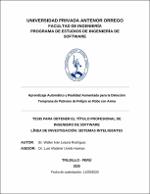Mostrar el registro sencillo del ítem
Aprendizaje automático y realidad aumentada para la detección temprana de patrones de peligro en robo con arma
| dc.contributor.advisor | Urrelo Huiman, Luis Vladimir | |
| dc.contributor.author | Leturia Rodríguez, Walter Iván | |
| dc.creator | Leturia Rodríguez, Walter Iván | |
| dc.date.accessioned | 2020-10-09T23:51:52Z | |
| dc.date.available | 2020-10-09T23:51:52Z | |
| dc.date.issued | 2020 | |
| dc.identifier.uri | https://hdl.handle.net/20.500.12759/6631 | |
| dc.description.abstract | América latina ostenta el título de ser la región que alberga el mayor número de ciudades más violentas del mundo. En el 2014, Perú lideró la mayor tasa de victimización por la delincuencia con 30% superando a Ecuador, Argentina y Venezuela, según la encuesta realizada por el Barómetro de las Américas. Los miembros del cuerpo policial disponen de dispositivos, vehículos y herramientas que les permiten ejercer sus funciones de una manera segura. Sin embargo no cuentan con un mecanismo efectivo, el cual permita identificar un robo a mano armada y concentrar sus esfuerzos en llevar a cabo una oportuna intervención, salvo su pericia. En tal sentido el presente trabajo desarrolla una propuesta basada en algoritmos de aprendizaje automático junto con detección de objetos, que permitirá la detección temprana ante la comitiva de un delito perpetrado bajo la modalidad de robo a mano armada. El algoritmo desarrollado en la presente investigación se aplicó en 3 escenarios, teniendo como resultado sobresaliente el escenario de paso peatonal, en el cual se logra identificar de manera correcta los objetos que interactúan durante la ejecución de un delito y el comportamiento anómalo, previo al delito, de parte del agresor. | es_PE |
| dc.description.abstract | Latin America holds the title of being the region with the most violent cities in the world. In 2014, Peru led the highest rate of crime victimization with 30% surpassing Ecuador, Argentina, and Venezuela, according to the survey conducted by the Barometer of the Americas. The members of the police force have devices, vehicles and tools that allow them to carry out their functions in a safe manner. However, besides their expertise, they do not have an effective mechanism, that makes it possible to identify an armed robbery and to concentrate their efforts on carrying out a timely intervention. In this sense, the present work develops a proposal based on automatic learning algorithms and object detection, which will allow the early detection of a crime perpetrated under the modality of armed robbery. The algorithm developed in the present investigation was applied in 3 scenarios, having as an outstanding result the pedestrian crossing scenario, in which it is possible to correctly identify the objects that interact during the execution of a crime and the anomalous behavior from the aggressor, prior to the crime. | en_US |
| dc.description.uri | Tesis | es_PE |
| dc.format | application/pdf | es_PE |
| dc.language.iso | spa | es_PE |
| dc.publisher | Universidad Privada Antenor Orrego - UPAO | es_PE |
| dc.relation.ispartofseries | T_INGS_005 | |
| dc.rights | info:eu-repo/semantics/closedAccess | es_PE |
| dc.rights.uri | https://creativecommons.org/licenses/by/4.0/ | |
| dc.source | Universidad Privada Antenor Orrego | es_PE |
| dc.source | Repositorio Tnstitucional - UPAO | es_PE |
| dc.subject | Realidad aumentada | es_PE |
| dc.subject | Aprendizaje automático | es_PE |
| dc.title | Aprendizaje automático y realidad aumentada para la detección temprana de patrones de peligro en robo con arma | es_PE |
| dc.type | info:eu-repo/semantics/bachelorThesis | es_PE |
| thesis.degree.level | Título Profesional | es_PE |
| thesis.degree.grantor | Universidad Privada Antenor Orrego. Facultad de Ingeniería | es_PE |
| thesis.degree.name | Ingeniero de Software | es_PE |
| thesis.degree.discipline | Ingeniería de Software | es_PE |
| dc.subject.ocde | http://purl.org/pe-repo/ocde/ford#2.02.04 | |
| dc.publisher.country | PE |


